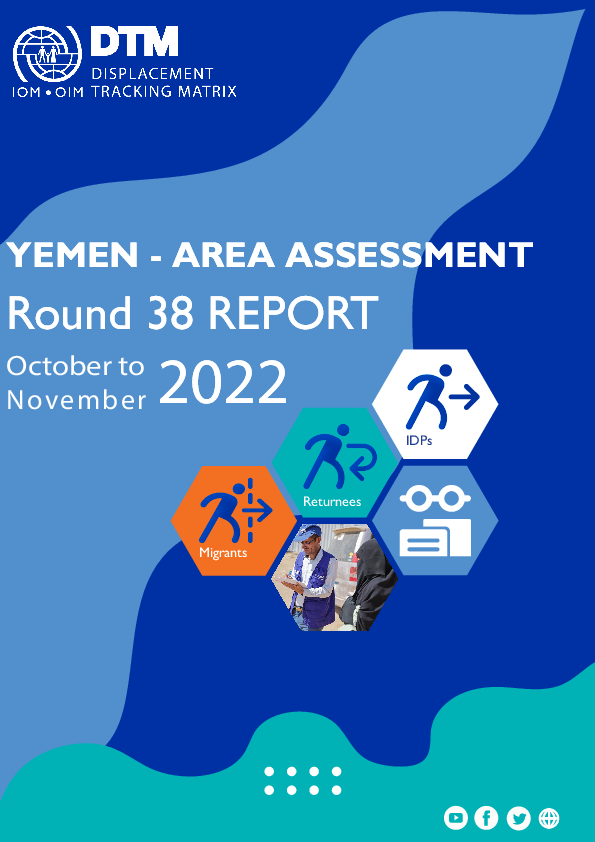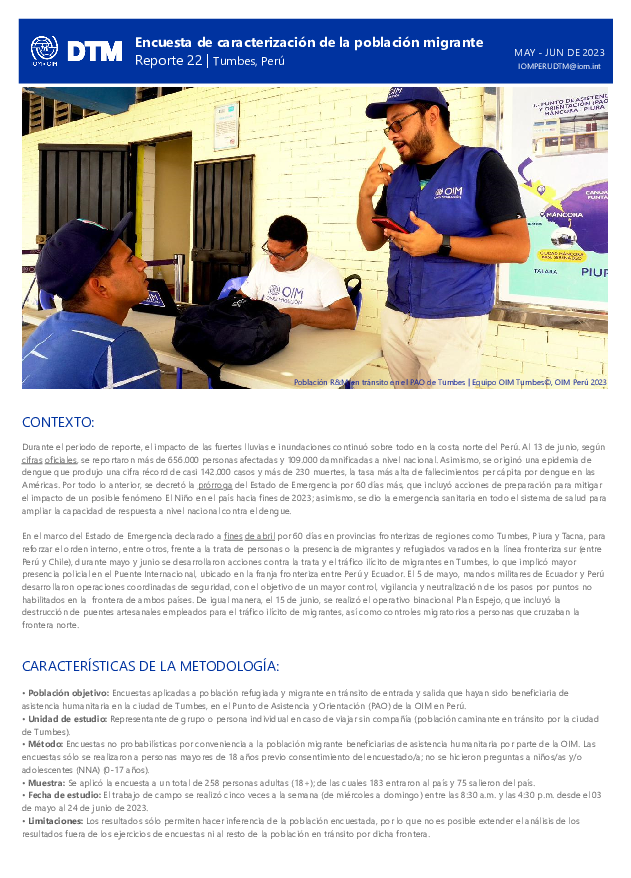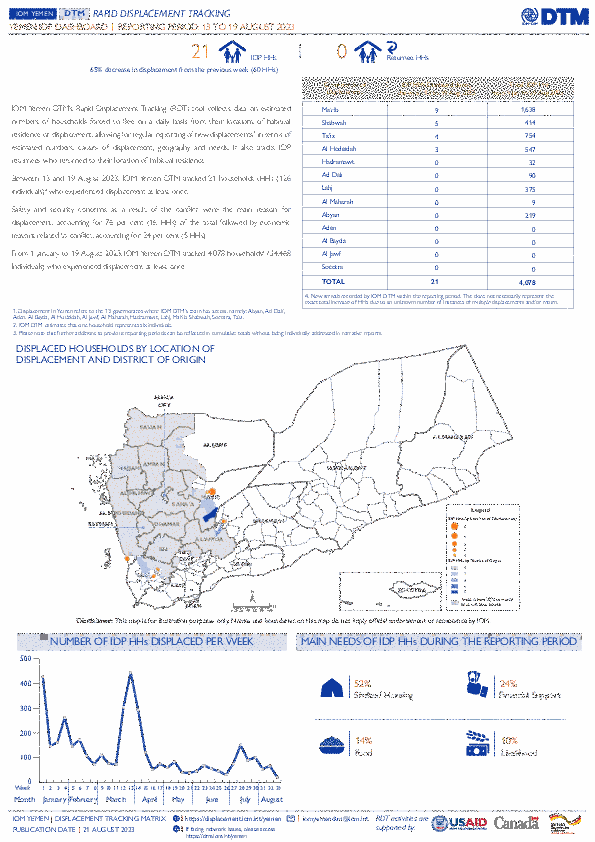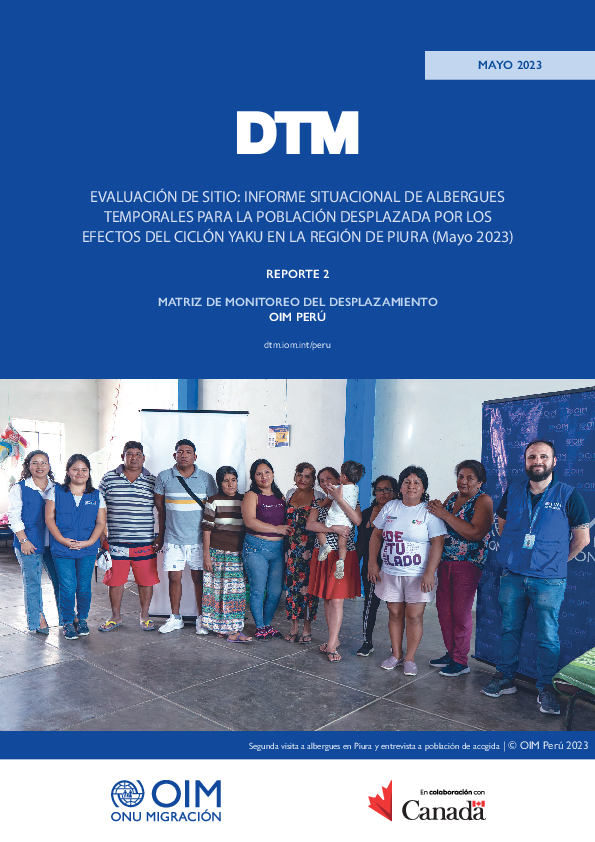-
Countries
-
Data and Analysis
-
Special Focus
-
Crisis Responses

Contact
DTM Yemen, iomyemendtm@iom.int
Language
English
Location
Yemen
Period Covered
Oct 01 2022
Nov 30 2022
Activity
- Migrants presence
- Mobility Tracking
This summary presents the findings of the 38th round of Area Assessment (Mobility Tracking) undertaken by IOM’s Displacement Tracking Matrix to establish a new baseline on the number of Internally Displaced Persons (IDPs), IDP returnees and migrants in Yemen.
Findings are currently limited to the country’s south controlled by the internationally recognized government (IRG). Data was collected by 153 enumerators through an extensive network of Key Informants (KIs) within the operational area. In the Yemen context, the practice for field teams is to select KI representatives of both the host and target communities while adhering to the humanitarian principles of humanity, neutrality, impartiality and operational independence.
This ensures that the selected KIs are the most relevant and appropriate individuals to ensure the successful implementation of the exercise. This round 3,633 KIs were interviewed to collect the data, of whom seven per cent or 270 were female and 93 per cent or 3,363 were male. Among the main outputs of the Sub-Area Assessment, is a list of locations where IDPs, returnees and / or migrants are present that can be used to inform more detailed assessments at the location level, including the annual Multi-Cluster Location Assessment (MCLA). DTM field staff, along with KIs, use the Sub-Area Assessment tool to capture locations, which are matched to the identified locations in the OCHA Common Operational Dataset (P-Codes).
Using a standardized and structured approach to the selection of KIs is a key step to ensuring that data collected in the Sub-Area Assessment is comprehensive and comparable across the different teams. The Sub-Area Assessment tool is used to verify and update the baseline information in regular intervals (rounds). Deployed DTM staff, called enumerators, are in regular communication with their KI network throughout each month and work continuously to maintain and expand this network to further triangulate the displacement statistics collected. The forms and definitions used can be accessed here. Please note that findings represent the results of a pilot round in this new format. The number of migrants indicated in this report represents a snapshot in time for a transient population located in areas data collection teams could access. Findings for Aden Governorate are not supported by Yemen’s Central Statistical Organization (CSO) and the Executive Unit for IDP Camps Management (ExU) for this round but will be further verified in the subsequent round of the Area Assessment in 2023. The ExU maintains that the current number of IDPs living in Aden stands at 145,857 individuals.
In a total of 394 sub-districts, IOM recorded a presence of IDPs in 364 sub-districts (92%), a presence of IDP returnees in 182 sub-districts (46%) and a presence of migrants in 74 sub-districts (19%).

Contact
Angélica Madrigal amadrigal@iom.int
Language
Spanish
Location
Costa Rica
Period Covered
Jan 01 2023
May 31 2023
Activity
- Survey
- Registration
- Flow Monitoring
Costa Rica, al igual que los demás países de la región centroamericana, se ha caracterizado por ser un corredor migratorio para personas que transitan de manera terrestre desde el sur hasta el norte de América y que tienen como destino los países del norte del continente. Este flujo en situación de movilidad por las Américas se encuentra compuesto principalmente por personas de la República Bolivariana de Venezuela, Cuba, Haití, Ecuador, así como personas provenientes de otros países de Suramérica, África y Asia.
Sixaola se ubica en la frontera sur de Costa Rica, es el distrito dos del cantón Talamanca, en la provincia Limón. Tanto Limón como Sixaola forman parte de las rutas migratorias alternas poco utilizadas por las personas en situación de movilidad por las Américas para migrar desde el sur hacia el norte del continente. A partir de los resultados del DTM a personas en movilidad por las Américas, alrededor de 2.000 personas de este flujo han transitado por las localidades mencionadas entre enero y mayo de 2023. Del total de personas que indicaron haber transitado por estas Sixaola y Limón, un 25% confirmaron haber ingresado al país por Sixaola.

Contact
DTMCostaRica@iom.int
Language
Spanish
Location
Costa Rica
Period Covered
Jul 01 2023
Jul 30 2023
Activity
- Flow Monitoring
- Mobility Tracking
- Event Tracking
Cantones: La Cruz, Liberia, Upala, Los Chiles, San Carlos, San Ramón, Alajuela, Heredia, San José, Osa, Golfito, y Corredores.
Costa Rica, al igual que los demás países de la región centroamericana, se ha caracterizado por ser un corredor migratorio para personas que transitan de manera terrestre desde el sur hasta el norte de América y que tienen como destino los países del norte del continente. Este flujo en situación de movilidad por las Américas se encuentra compuesto principalmente por personas de la República Bolivariana de Venezuela, Cuba, Haití, Ecuador, así como personas provenientes de otros países de Suramérica, África y Asia.
Según las cifras reportadas por la Estación Temporal de Recepción Migratoria (ETRM) de los Planes de Gualaca, Panamá, durante 2022 se identificó un aumento del 79 por ciento en el volumen del flujo de personas en movilidad, en comparación con 2021; (se registraron 126.512 salidas de la ETRM durante 2021 y 226.610 salidas durante 2022). Durante julio salieron de la ETRM 54.685 personas que, potencialmente, ingresaron a Costa Rica a través de la frontera sur, lo que representa un aumento de un 98% con respecto al flujo de junio de 2023. Además, se identificaron 748 personas varadas en los albergues monitoreados y 4.799 personas varadas en los sitios públicos visitados.

Contact
DTM Peru, IOMDTMPeru@iom.int
Language
Spanish
Location
Peru
Period Covered
May 01 2023
Jun 30 2023
Activity
- Flow Monitoring
Durante el periodo de reporte, el impacto de las fuertes lluvias e inundaciones continuó sobre todo en la costa norte del Perú. Al 13 de junio, según cifras oficiales, se reportaron más de 656.000 personas afectadas y 109.000 damnificadas a nivel nacional. Asimismo, se originó una epidemia de dengue que produjo una cifra récord de casi 142.000 casos y más de 230 muertes, la tasa más alta de fallecimientos per cápita por dengue en las Américas. Por todo lo anterior, se decretó la prórroga del Estado de Emergencia por 60 días más, que incluyó acciones de preparación para mitigar el impacto de un posible fenómeno El Niño en el país hacia fines de 2023; asimismo, se dio la emergencia sanitaria en todo el sistema de salud para ampliar la capacidad de respuesta a nivel nacional contra el dengue.
En el marco del Estado de Emergencia declarado a fines de abril por 60 días en provincias fronterizas de regiones como Tumbes, Piura y Tacna, para reforzar el orden interno, entre otros, frente a la trata de personas o la presencia de migrantes y refugiados varados en la línea fronteriza sur (entre Perú y Chile), durante mayo y junio se desarrollaron acciones contra la trata y el tráfico ilícito de migrantes en Tumbes, lo que implicó mayor presencia policial en el Puente Internacional, ubicado en la franja fronteriza entre Perú y Ecuador. El 5 de mayo, mandos militares de Ecuador y Perú desarrollaron operaciones coordinadas de seguridad, con el objetivo de un mayor control, vigilancia y neutralización de los pasos por puntos no habilitados en la frontera de ambos países. De igual manera, el 15 de junio, se realizó el operativo binacional Plan Espejo, que incluyó la destrucción de puentes artesanales empleados para el tráfico ilícito de migrantes, así como controles migratorios a personas que cruzaban la frontera norte.

Contact
DTMUkraine@iom.int
Language
Ukrainian
Location
Ukraine
Period Covered
Jun 01 2023
Jun 30 2023
Activity
- Return Intention
- Mobility Tracking
Цей Інформаційний бюлетень містить загальний огляд даних раунду 3 Оцінка умов повернення (CoRA), проведеного в травні–червні 2023 року в 51 громаді 14 областей. Для отримання повної версії звіту з операційним набором даних, що містить розрахунки чисельності населення та даних щодо умов із розподілом за населеними пунктами і громадами надішліть запит на адресу: DTMUkraine@iom.int.

Contact
RO Dakar, RODakar-DataResearch@iom.int
Language
English
Location
Nigeria
Period Covered
Jul 01 2023
Jul 31 2023
Activity
- Other
- Event Tracking
In northern Nigeria and other Sahel regions, the escalation of hostility and violent conflicts between transhumant herders and farmers are linked to several key factors. One of the main contributors is the competition over natural resources, which is exacerbated by the low rainfall, insecurity, insurgency, growing population and the attendant land-intensive demands for both farming and transhumance activities. Additionally, year-round farming and the conventional methods of land allocation to farming and herding activities add to the tensions, as farmers may encroach on designated grazing areas and routes, and herders in turn resort to destructive practices such as trespassing on farmlands, causing crop destruction and polluting water sources to feed their cattle. These factors sometimes result in deadly conflicts.
To better understand trends in transhumance movements, assess impact of conflicts and mitigate the transhumant herders and sedentary farmers conflicts, the Transhumance Tracking Tools (TTT) as a component of the IOM's Displacement Tracking Matrix (DTM) and supported by a network of community key informants, operationalised the Early Warning System in the selected 9 LGAs in the adjoining states of Adamawa and Taraba. The triangulated 287 alerts were those that are linked to events or massive/unexpected transhumance movements that resulted from farmers-herders conflicts in the two states (7 and 2 LGAs of Adamawa and Taraba state respectively).
Contact
DTM Yemen, iomyemendtm@iom.int
Location
Yemen
Activity
- Mobility Tracking
- Event Tracking
Period Covered
Aug 13 2023 -Aug 19 2023
From 1 January to 19 August 2023, IOM Yemen DTM tracked 4,078 households (HH) (24,468 Individuals) who experienced displacement at least once.
Between 13 and 19 August 2023, IOM Yemen DTM tracked 21 households (126 individuals) displaced at least once. The majority of people moved into/within the following governorates and districts:
- Ma’rib (9 HHs) – Ma’rib (5 HHs), Ma’rib City (4 HHs) districts. Most displacements in the governorate originated from Ma’rib and Ibb.
- Shabwah (5 HHs) – Bayhan (5 HHs) district. Most displacements in the governorate originated from Al Bayda and Ma’rib.
- Ta’iz (4 HHs) – Jabal Habashi (2 HHs), Salah (1 HH), Al Qahirah (1 HH) districts. All displacements in the governorate were internal.
- Ma’rib (7 HHs) – Harib (5 HHs), Al Jubah (2 HHs) districts.
- Ta’iz (4 HHs) – Maqbanah (2 HHs), Sharab As Salam (1 HH), At Ta’iziyah (1 HH) districts.
- Al Hodeidah (3 HHs) – Al Mina (1 HH), Bayt Al Faqih (1 HH), Hays (1 HH) districts.
Population Groups
Survey Methodology
Unit of Analysis Or Observation
Type of Survey or Assessment
Keywords
Geographical Scope
Administrative boundaries with available data
The current dataset covers the following administrative boundaries

Contact
DTM Yemen, iomyemendtm@iom.int
Language
English
Location
Yemen
Period Covered
Aug 13 2023
Aug 19 2023
Activity
- Mobility Tracking
IOM Yemen DTM’s Rapid Displacement Tracking (RDT) tool collects data on estimated numbers of households forced to flee on a daily basis from their locations of origin or displacement, allowing for regular reporting of new displacements in terms of estimated numbers, geography, and needs. It also tracks returnees who returned to their location of origin.
From 1 January to 19 August 2023, IOM Yemen DTM tracked 4,078 households (HH) (24,468 Individuals) who experienced displacement at least once.
Between 13 and 19 August 2023, IOM Yemen DTM tracked 21 households (126 individuals) displaced at least once. The majority of people moved into/within the following governorates and districts:
- Ma’rib (9 HHs) – Ma’rib (5 HHs), Ma’rib City (4 HHs) districts. Most displacements in the governorate originated from Ma’rib and Ibb.
- Shabwah (5 HHs) – Bayhan (5 HHs) district. Most displacements in the governorate originated from Al Bayda and Ma’rib.
- Ta’iz (4 HHs) – Jabal Habashi (2 HHs), Salah (1 HH), Al Qahirah (1 HH) districts. All displacements in the governorate were internal.
The majority of people moved from the following governorates and districts:
- Ma’rib (7 HHs) – Harib (5 HHs), Al Jubah (2 HHs) districts.
- Ta’iz (4 HHs) – Maqbanah (2 HHs), Sharab As Salam (1 HH), At Ta’iziyah (1 HH) districts.
- Al Hodeidah (3 HHs) – Al Mina (1 HH), Bayt Al Faqih (1 HH), Hays (1 HH) districts.

Contact
DTMUkraine@iom.int
Language
Ukrainian
Location
Ukraine
Snapshot Date
Aug 04 2023
Activity
- Survey
24 лютого 2022 року Російська Федерація (РФ) розпочала повномасштабне вторгнення в Україну, що спричинило безпрецедентну гуманітарну кризу по всій Україні. Починаючи з 9 березня 2022 року, відділ даних та аналітики МОМ почав систематично проводити репрезентативне оцінювання загального населення України для збору інформації стосовно переміщення, потоків мобільності, намірів й умов для інформаційного забезпечення цільової допомоги населенню, що постраждало від війни. У період із березня 2022 р. по січень 2023 р. відділ даних та аналітики МОМ успішно провів 12 раундів Опитування загального населення. Початково опитування проводилося раз на два місяці, а згодом — щомісяця; результати Опитування було екстрапольовано як на загальнонаціональний, так і на макрорегіональний рівнях. Станом на травень 2023 р. методологія дослідження була адаптована для генерування квартальних репрезентативних даних на рівні областей, таким чином сприяючи локалізованому аналізу. У методологічній записці окреслено комплексну методологію оцінювання та дизайн вибірки.

Contact
IOMPERUDTM@iom.int
Language
English
Location
Peru
Period Covered
May 22 2023
May 29 2023
Activity
- Mobility Tracking
- Site Assessment
La DTM es una herramienta que la OIM implementa a nivel global con el objeto de capturar, procesar y difundir información sobre el monitoreo del desplazamiento y movilidad humana en situaciones de emergencia, así como
en contextos migratorios.
Bajo el contexto de la emergencia por las fuertes lluvias e inundaciones en el Norte de Perú, la OIM desarrolló la DTM Evaluación de Sitio en albergues temporales en la región de Lambayeque a fin de recopilar datos sobre las características, condiciones, perfil demográfico, necesidades y posibles riesgos a los que están expuestos; así como identificar soluciones duraderas que contribuyan a la mejora de la gestión y coordinación de los albergues de la región de Lambayeque en el periodo de análisis (mayo 2023).